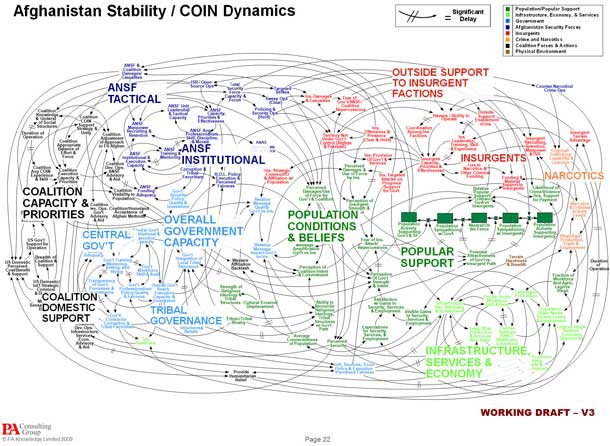Facts are getting in the way of the idea that Afghan corruption is hindering America’s noble efforts to rob, kill and destroy save that poor, benighted country.
According to the AP:
The U.S. agency overseeing the multibillion dollar Afghanistan reconstruction effort is investigating 38 criminal cases ranging from contract fraud to theft – most involving non-Afghans, officials said Tuesday…Just 10 of the criminal cases under the microscope involve Afghans only, while the rest involve U.S. and other foreigners, according to Raymond DiNunzio, the agency’s assistant inspector general for inspections.
And in not unrelated news, the President is asking Congress for another “$33 billion to fight unpopular wars in Afghanistan and Iraq, on top of a record request for $708 billion for the Defense Department next year.”
And this is yet another must-read piece from Tomdispatch about “a tale of a new-style battlefield that the American public knows remarkably little about, and that bears little relationship to the Afghan War as we imagine it or as our leaders generally discuss it.”
We don’t even have a language to describe it accurately. Think of it as a battlefield filled with muscled-up, militarized intelligence operatives, hired-gun contractors doing military duty, and privatized “native” guard forces. Add in robot assassins in the air 24/7 and kick-down-the-door-style night-time “intelligence” raids, “surges” you didn’t know were happening, strings of military bases you had no idea were out there, and secretive international collaborations you were unaware the U.S. was involved in. In Afghanistan, the American military is only part of the story. There’s also a polyglot “army” representing the U.S. that wears no uniforms and fights shape-shifting enemies to the death in a murderous war of multiple assassinations and civilian slaughter, all enveloped in a blanket of secrecy.
… Today, in Afghanistan, a militarized mix of CIA operatives and ex-military mercenaries as well as native recruits and robot aircraft is fighting a war “in the shadows” (as they used to say in the Cold War era). This is no longer “intelligence” as anyone imagines it, nor is it “military” as military was once defined, not when U.S. operations have gone mercenary and native in such a big way. This is pure “lord of the flies” stuff — beyond oversight, beyond any law, including the laws of war. And worse yet, from all available evidence, despite claims that the drone war is knocking off mid-level enemies, it seems remarkably ineffective. All it may be doing is spreading the war farther and digging it in deeper.
Talk about “counterinsurgency” as much as you want, but this is another kind of battlefield, and “protecting the people” plays no part in it. And of course, this is only what can be gleaned from afar about a semi-secret war that is being poorly reported. Who knows what it costs when you include the U.S. hired guns, the Afghan contractors, the bases, the drones, and the rest of the personnel and infrastructure? Nor do we know what else, or who else, is involved, and what else is being done. Clearly, however, all those billions of “intelligence” dollars are going into the blackest of black holes.






